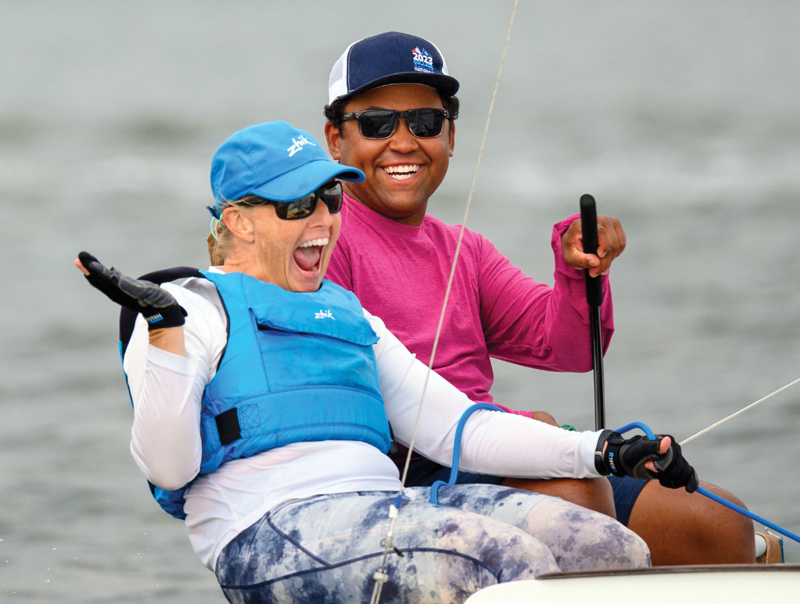Grownups: Love your one-design sailing class? Help form the bridge for younger sailors to join you.
Getting more young people sailing is great for our sport. Fostering the next generation of small-boat racers is key to the future! Junior sailing programs play an important role in introducing young sailors to racing in boats such as Optis and 420s. But once sailors “graduate” from those boats, what’s next?

Savvy one-design classes are making an effort to introduce young sailors to their boats—to create a bridge between junior sailing and adult one-design sailing. ILCA (“Laser”) sailors have long mentored junior sailors and helped them adapt to the differences between high school/college sailing and long-course sailing as well as how to sail in a fleet where you’ll be sailing against friends for life. The Lightning Class runs a fantastic boat grant program that lets teams of young sailors sail a boat for a full season and learn from terrific mentors. Other classes and fleets have “loaner” boats that sailors can try out and learn in, and some offer “lease to own” programs to help young sailors—especially those in the few years just out of college—buy a boat on more comfortable terms than taking out a loan from a bank.
Access to a one-design boat is great; learning how to sail it fast and smart is even better. The Snipe Class has long been an advocate of encouraging and supporting younger sailors to join the fun on the racecourse and in the boat park. While Snipe Junior National Championships have been held for many years to highlight the top sailors under 22 years of age, more recently, fleets have started holding events for “U30” sailors: those under 30.
The Annapolis Snipe Fleet recently hosted the Annapolis Snipe Invitational and U.S. Junior National Championship at Severn Sailing Association (SSA). The event included three divisions: junior (skipper and crew both less than 22 years old), U30 (skipper and crew both under 30), and special junior (skipper less than 22 years old; crew any age). Sailors had lots of fun and learned a ton during a Friday-afternoon clinic (including onshore and on-the-water sessions) and Saturday and Sunday racing.
The other side of the equation is equally fun and important: The O30 (Over 30) sailors! We grownups love helping with things like this. I enjoyed spending my weekend immersed in the regatta. When our club opened up signups to serve on the race committee, I eagerly signed up for both days. When one of the young sailors’ crew couldn’t make it for the clinic, I said, “Heck yes, I’d love to stand in as crew for you that day.”
Preston Anderson, my skipper for that session, is an accomplished sailor. He began sailing at a junior program in Chicago, started a sailing team at his high school, and competed collegiately at Bowdoin College. He’s a volunteer assistant coach for the Georgetown University sailing team. He started sailing Snipes more recently and is using an older-model Snipe that’s owned by the Annapolis fleet for the summer.
As we were packing up the previous weekend after the Snipe Colonial Cup, Preston asked if we could find time to get out on the water together. While he’s found some solid success in the class, he’s eager to learn more. It made sense to have someone who has spent a long time (full disclosure: "long time” here means longer than Preston has been alive) in the front of the Snipe to be able to offer some tips and potentially identify some tweaks to the older-style boat that could make things run more smoothly.
The clinic ended up being sailed in a super puffy, shifty late afternoon. While it wasn’t a great session for practicing boatspeed, we were able to talk through a few crewing, boat setup, and speed tips. We kept a list of changes to make to the boat, some of which could be accomplished overnight and some of which are considerations for the rest of the summer.
And I got to come back to SSA the following two days to serve on race committee for the regatta itself. It always feels good to give back to our sport by helping make a regatta happen. Add on the extra layer of having volunteer time support a regatta that’s helping younger sailors get established in an awesome one-design fleet? It’s fantastic!
The exchange of ideas and energy between the more experienced Snipe sailors and the young sailors is a terrific model for how to ensure a sustainable future for a one-design class. If you love your one-design class, be sure you’re helping form the bridge for younger sailors to join you. And if you’re a younger sailor, come sail a Snipe—us old fogies are happy to help make it happen for you!
By Kim Couranz
About the Author: SpinSheet Small Boat columnist for more than a dozen years, Kim Couranz has earned several national and world titles in Laser Radials (ILCA 6) and Snipes. She has also raced J/22s, J/24s, and Ynglings on an international level.




